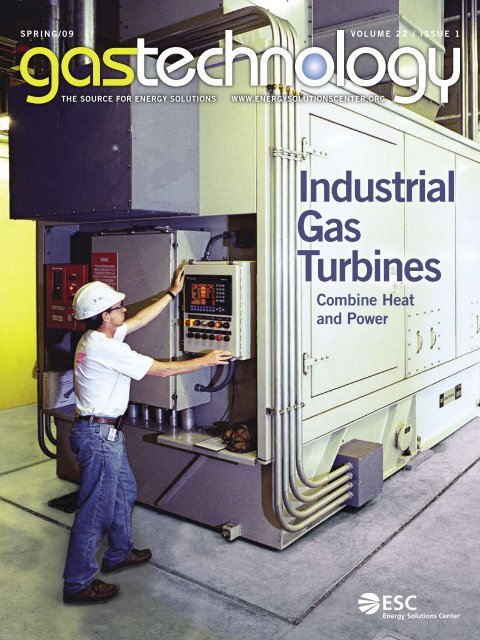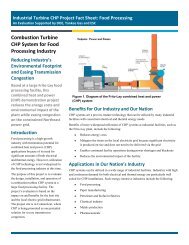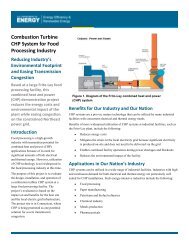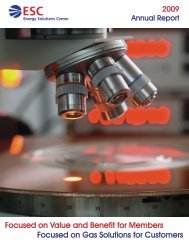Industrial Gas Turbines - Energy Solutions Center
Industrial Gas Turbines - Energy Solutions Center
Industrial Gas Turbines - Energy Solutions Center
Create successful ePaper yourself
Turn your PDF publications into a flip-book with our unique Google optimized e-Paper software.
insideon the coverThis Taurus 60 unit by Solar <strong>Turbines</strong>equipped with a heat recovery steamgenerator (HRSG) serves an EastCoast pharmaceutical manufacturingplant. The unit is rated at 5.5 MW.Photo courtesy Solar <strong>Turbines</strong>.<strong>Gas</strong> Technology is a trademark of <strong>Energy</strong><strong>Solutions</strong> <strong>Center</strong> Inc. and is publishedin cooperation with Reed BusinessInformation.<strong>Gas</strong> Technology is an educationalsupplement from:<strong>Energy</strong> <strong>Solutions</strong> <strong>Center</strong> Inc.400 N. Capitol St., N.W.Washington, DC 20001 (202) 824-7150 www.energysolutionscenter.orgDavid Weiss, Executive DirectorJake DelwicheContributing EditorComments may be directed to:<strong>Gas</strong> Technology EditorPlant Engineering Magazine2000 Clearwater Dr.Oak Brook, IL 60523 (630) 288-8789Printed in the USAenergy solutions center websiteswww.aircompressor.orgwww.cleanboiler.orgwww.energysolutionscenter.orgwww.naturalgaseffi ciency.orgwww.gasairconditioning.orgwww.poweronsite.orgwww.foodtechinfo.comA3Use All of the <strong>Energy</strong><strong>Industrial</strong> <strong>Gas</strong> <strong>Turbines</strong> allow industry and institutions tocapture both efficient electric generation and a rich sourceof byproduct heat for steam or hot water. The solution is acombined heat and power (CHP) design.A6 Water Heating MiracleDirect contact water heaters have effi cienciesapproaching 100% and provide large quantities ofhot water on demand. Find out why this solution isgrowing in popularity.A9 Squeezing More Efficiency out of HeatTreating BurnersToo often we forget about burner effi ciency in heattreat ovens and furnaces. Learn how a little attentioncould produce a gold mine of energy savings.A11 Putting More Tools in Your PlantEfficiency ToolboxCheck out opportunities for additional energysavings with new tools and even possible dollarassistance from utilities, associations and thegovernment.
INDUSTRIAL-SCALE TURBINESGaining RespectHeat Recovery Makes the DifferenceWITH FLUCTUATING ENERGY PRICES and ever-increasingemphasis on operating economies, mid-sized industrial gas turbinesfeel right at home. Several configurations help industrialenergy users take more complete advantage of the energy theypurchase, and offer added energy supply security. The keys arenewer turbine designs and cost-effective heat recovery.Defining the Sweet Spot for Industry<strong>Industrial</strong> machines are bracketed between the microturbines thatgenerate from 30 to several hundred kW for residential and commercialmarkets, and utility-scale machines that put out 25 to 300MW. This industrial size category – 1.0 to 20 MW – is ideal forindustrial and institutional users that want a reliable source ofself-generation and are able to use the substantial byproduct heatin a variety of applications.Larger simple-cycle gas turbines are commonly used by centralstationelectric utilities for peaking generation. Annual operatinghours are generally limited and usually no attempt is made tosalvage waste heat. For longer run-hour applications, combinedcycledesigns direct the gas turbine exhaust at temperatures upto 1000° F to a heat-recovery steam generator (HRSG) and thesteam is then used to operate a steam turbine-generator.Unit Efficiencies Are Better Than EverBut it is the industrial and institutional users that are uniquelypositioned to take the most complete advantage of the dual energyoutputs. Today’s mid-sized gas turbines have heat rates substantiallybetter than those of a few decades ago, meaning the outputof electric energy and the generation of byproduct steam is muchmore balanced. The HRSG produces steam that can be used for avariety of applications. These include smaller scale versions of theutility combined-cycle generation scheme as outlined above or, orfor water heating, food processing, space heating, absorption cooling,and many other process uses.Aeroderivative and <strong>Industrial</strong> Designs MergingIn the past, much attention was given to the distinctions betweenthe aeroderivative family of gas turbines and the industrial or“frame-built” family of machines. Aeroderivative turbines are descendantsof turbine designs originally used for aircraft engines.This 5.5 MW Taurus 60 SoLoNOx unit by Solar <strong>Turbines</strong> replaced a coal-fi redgenerating unit at a Midwestern university campus. Photo courtesy Solar <strong>Turbines</strong>.WWW.ENERGYSOLUTIONSCENTER.ORG gastechnology / SPRING 09 A3
natural gas-fired simple-cycle gas turbinesfor standby generation. Dual fuel designs allowthese systems to start on liquid fuel butfor longer runs – days or weeks – to switchto pipeline-supplied gas, which in mostsituations is highly reliable. “This allowsthese customers to pay for their backup fuelwhen they use it, as opposed to buying itup front and storing large quantities on siteawaiting an emergency.“Rooftop Installation an OptionHe adds, “These units are also light in weightcompared to the diesel engine alternativesand can be roof-mounted to save space. OurGPS gas turbine units can go from start tofull load in 40 seconds, making them quitecompetitive for standby power.”Cernik gives as an example of a successfulCHP installation one at the BridgewaterCorrectional Complex, operated by theMassachusetts Department of Correction.According to Todd Gundlach, Deputy Directorof the Department’s Division of ResourceManagement, this site has a centralpower plant with three boilers for facilitysteam supply, as well as an electric distributioncenter. The complex had a longstandingproblem with service interruptions,requiring frequent startups of theirstandby generation equipment.In 2006 the facility negotiated an energysaving performance contract whichinvolved a wide range of improvements,including water saving devices, variablefrequency motor drives, window replacementsand improvements to the steamdistribution system. They also decided toinstall a 1.5 MW Kawasaki gas turbine togetherwith a HRSG to supply most of theirrequired site electric power as well as toaugment the existing steam supply. Gundlachsays, “Heat utilization is what makesthis project practical. The HRSG supplies125 psi steam to match the existing boileroutput. The steam is used for heating, laundry,cooking and water heating. Gundlachnotes, “The State Division of Capital AssetManagement was impressed with the potentialenergy savings, and has asked us tohandle referrals from other state agencies.”Since startup in 2006, the turbine-generatorhas logged over 17,000 operatinghours and supplies over 90% of the requiredsite electric energy. The site still hasan operating connection with the electricutility, but the turbine normally operatesover 660 hours per month. Gundlach indicateshe would recommend this type installationto any similar institution. “To makethis work, you have to take advantage ofthe byproduct steam. That’s why it’s importantthat the turbine isn’t oversized.”Today’s gas turbines are available in awide range of sizes for the industrial andinstitutional markets. Emissions are extremelylow and efficiency, especially withbyproduct heat recovery, is exceptionallyhigh. For all or part of your on-site electricand heat requirements, the gas turbinemay be the perfect solution. If you haven’tstudied this option, now is the time. GTMOREinfoDOE INFO ON CHP APPLICATIONShttp://www.eere.energy.govENERGY SOLUTIONS CENTER INFO ON CHPhttp://www.energysolutionscenter.org/tech/tech_cogen.aspGENERAL ELECTRICwww.gepower.comKAWASAKIwww.kawasakigasturbines.comSOLAR TURBINESwww.solarturbines.comThis 4.6 MW Mercury recuperative gas turbine by Solar <strong>Turbines</strong> provides hot water for a university hospitalin France, and provides surplus electric energy to the regional grid. Photo courtesy Solar <strong>Turbines</strong>.WWW.ENERGYSOLUTIONSCENTER.ORG gastechnology / SPRING 09 A5
DIRECT-CONTACTProviding Efficient Hot WaterWATERHEATINGBECAUSE OF ITS EFFICIENCY and its instant output, directcontactwater heating is an interesting option for large volume usersof hot water. The basic principle is to apply the hot natural gasburner exhaust directly to a spray or cascade of cold water. Heatand combustion products move upward as the water descends,resulting in a virtually complete utilization of the heat and a moreload-responsive, immediate supply of hot water.Direct-contact water heaters are ideal for laundries, large commercialkitchens, food processing plants, concrete plants, fertilizerplants, greenhouses and other medium to large volume usersof hot water. Direct-contact can also be used to supply hydronicheating systems, and to preheat boiler-makeup water.No Pressure Vessel NeededDirect-contact systems operate at atmospheric pressure, eliminatingthe need for a pressure vessel and related code requirements.Manufacturers in this growing market include ArmstrongInternational, Kemco, Ludell, QuikWater, and Sofame TechnologiesTammy Collins from QuikWater was a presenter at a TechnologyMarketing and Assessment Forum sponsored by the <strong>Energy</strong><strong>Solutions</strong> <strong>Center</strong> in Kansas City in October, 2008. QuikWater offers16 standard models producing from 12 to 700 gpm at a 100°Ftemperature rise. The design pushes heated products of combustionthrough a heat exchange vessel packed with specially designedstainless steel rings. Heat from combustion is transferreddirectly to downward-moving water.Collins notes that the direct-contact method has numerous advantages.“These units are 99% energy efficient and can provideenergy savings of up to 40%, depending on what type of unit theyare replacing. This means they can provide a very quick return oninvestment.”A6 gastechnology / SPRING 09 WWW.ENERGYSOLUTIONSCENTER.ORG
Limitations with a BoilerCollins claims that steam-to-hot water systems using an indirectsource such as a steam/water heat exchanger, even with a wellmaintainedboiler and full heat recovery, are at best 69% efficient.She says, “With direct-contact water heating you should see atleast a 30% saving on fuel use for generating the same amountof hot water.”Because they operate at atmospheric pressure, no permits or inspectionsare required, nor does a licensed boiler operator need tobe on the premises. “Also,” she says, “they provide hot water ondemand, so there are virtually no standby losses. This is importantin operations where the demand for hot water is intermittent.”The QuikWater burner can be modulated to adjust to varying hotwater demands. A low-NOx burner is available for air complianceregions.Lowest-Cost SolutionAsked about an equipment cost comparison between the Quik-Water system and a traditional fire-tube boiler, Collins indicates,“The QuikWater system comes in lower — hands down.” She“ ”If you need hot water, dothe math.Mark Schwenneker, Tyson FoodsTyson Foods operates numerous facilities throughout NorthAmerica, as well as other regions. Mark Schwenneker, DirectorEngineering Renewable Fuels Operations with the fi rm,notes that Tyson has traditionally used steam-boiler generatedhot water at its facilities, but has begun replacing older steamsystems with direct-contact water heating in many situations.He has used the QuikWater systems in several plants.He points out, “I don’t believe there is any argument on thissubject. The direct-contact heater is much more effi cient.”Schwenneker sees opportunities for this technology for variousapplications. He suggests that many facilities need hotwater at varying temperatures for different operations, anddirect-contact units have the fl exibility to meet these multipleneeds, but always at a high effi ciency. “Or a heater could providepreheated makeup water either to a deaerator or boilerfeedwater tank, eliminating much of the steam required forthese applications.“I would only say, if you need hot water, do the math. Evaluatethe savings vs. cost between steam and a direct-contactsystem. If it’s a new installation and you don’t need the temperaturesthat steam can provide, it’s a no-brainer—directcontact is the way to go.”says, for example,a dedicated boilersystem with an outputof 6.0 MMBtu/hr will cost roughly45% more than thecomparable Quik-Water system. Regardingservice lifeof such a system,Collins suggests thata well-maintainedsystem can last alifetime. “We haveunits with 20+ yearson them, still operating.”The comparatively small footprint and highefficiency of direct-contact water heaters makethem ideal for many institutional and industrialinstallations. Photo courtesy Ludell Manufacturing.A Quikwater system is used to supply hot water to maintain thetemperature of rearing tanks for commercially raised alligators atDonald Farms in West Monroe, Louisiana. Proprietor Jeff Donaldsays the farm uses up to 300,000 gallons of heated water per dayto supply the insulated tanks in barns. Donald remembers, “Wepreviously used a swimming pool heater that we modified for thisapplication. We went to the direct-contact system for its improvedefficiency and its ability to handle a large volume of water.”Using Boiler ExhaustAlthough it uses a different approach, a similar result is achievedwith the Percotherm direct-contact condensing stack economizerby Sofame Technologies of Quebec. Boiler exhaust gasesare blown upward through a vessel filled with stainless steel elements.A cold water spray courses downward through the packingsection vessel, en route picking up the heat from the exhaustgases. Because it more fully extracts the heat from the boiler, thisunit can actually improve the efficiency of the boiler system, andcan help take fuller advantage of low-firing boiler capacity duringsummer months.In addition to the Percotherm condensing stack economizer, Sofamealso offers its Percomax direct-contact water heater, whichuses a dedicated burner that exhausts through the heat exchangevessel. The Percotherm and Percomax systems can be combinedat locations where there is a hot boiler exhaust and the need forlarge quantities of hot water.An example of a successful combination of the two systems is atSacré Coeur Hospital in Montreal. Here older boilers were recentlyreplaced with two new 6 MW boilers, a Percotherm condensingstack economizer, and a Percomax direct-contact water heater. Asa result of the installation, the hospital now generates hot waterat efficiencies exceeding 95%.John Rivers from Armstrong International’s Hot Water Groupemphasizes the efficiency of the direct contact approach. p He notesWWW.ENERGYSOLUTIONSCENTER.ORG gastechnology / SPRING 09 A7
Kemco Systems Inc. also offers a widerange of industrial water heating andtreatment systems. According to Kemco’sJohn O’Hehir, the company has sold direct-contactsystems since 1985, and theseunits make sense for a wide range of applications.“Compared to boiler systems, it’snot just lower first cost, but lower systemmaintenance as well. You don’t have thatdaily list of tasks that you have for a boilersystem. And you don’t have to have an operatorin attendance.”O’Hehir indicates that the 99.8% efficiencydesign of the Kemco product continuesto attract new converts. “Ready-mixconcrete companies are a good application.They need large volumes of hot water onan irregular schedule. A direct-contactsystem is perfect for them.” Other majormarkets for Kemco are commercial and institutionallaundries and the food industry.O’Hehir says, “The food industry uses hugevolumes of hot water not just for processingbut for plant cleanup and sanitation.There are typically one or two big demandperiods for cleanup water on each shift.The direct-contact heater can answer thisneed easily.”Multiple units can be combined to increase capacity or to providediverse hot water temperatures. Photo courtesy Kemco Systems.that the direct-contact water heating conceptdates back to 1908.He explains that the reason for his company’sclaimed 99.7% unit efficiency isToday’s systems areso efficient that theyare practical to use forapplications such asboiler makeup water,hydronic heating, andfood processingwater sterilization.“”that there are no stack losses, no storageradiant heat losses, no scale buildup, nocondensate losses and no idle run time.He compares this with boiler systems thatoffer 80% at best, and often it is closer to60%. Armstrong offers units with outputsranging from 15 gpm to 10,000+ gpm.One of the veterans in the field of direct-contactwater heaters is Ludell Manufacturing,a division of Ellis Corporation.According to Greg Thorn from Ludell, hisfirm has patents for direct-contact waterheating equipment ent going back to 1986.The equipment features very high efficiency,delivering 180° F water at efficiencygreater that 99%.The Ludell heater features corrosionresistant stainless vessel construction, giv-ing it longer life than carbon steel vessels.The vessel is welded to ASME standards,but doesn’t require a certified ASME stampin order to perform repairs in the field ifever necessary. Thorn also notes that, un-like boiler systems, the Ludell unit can usewater that has not been chemically treatedor deaerated.Wide Range of ApplicationsInterface with Process ControlsO’Hehir says that recent developments inthe product line largely involve more sophisticatedand flexible controls. “Todaywe are often asked to design water heatercontrols that can interface with processcontrol systems. Today’s controls can becustomized to meet that requirement.”The manufacturers all emphasize thatthey can provide systems customized tomeet the needs of a wide range of customers.O’Hehir says, “We suggest that an interestedcustomer get in contact with us.We will study their application; even senda rep to their site at no charge to completelyunderstand their hot water needs.Then we can design a system that willcompletely meet their needs, now and forthe future.”GTMOREinfoARMSTRONG INTERNATIONALhttp://www.armstronginternational.com/fbfl odirectKEMCO SYSTEMSwww.kemcosystems.comLUDELL MANUFACTURING COMPANYwww.elliscorp.comQUIKWATERwww.quikwater.comSOFAME TECHNOLOGIEShttp://www.sofame.comA8 gastechnology / SPRING 09 WWW.ENERGYSOLUTIONSCENTER.ORG
This furnace at Rock River Heat Treat wasupgraded with the installation of six EclipseAutoRecupe SER burners, reducing processtime suffi cient to allow three additionaltreatment loads per day. Photo courtesy Eclipse.BETTERHeatTreatmentWITH LESS WASTED ENERGYHEAT TREATMENT IS AN ESSENTIAL ELEMENT in modern metallurgicalpractice. The goal may be hardening, tempering, annealing, stress relief, orother modifications of the metal. The right heat treatment, followed by the rightcooling process, changes the characteristics of metal, making it harder, softer,tougher, more malleable or more ductile. Most frequently, the heat originatesfrom a natural gas-fired burner and the treatment takes place in an oven or furnace.Both ferrous and non-ferrous metals commonly receive heat treatment.Staged air combustion has become a widespreadtechnique for improved burner effi ciency and reducedNOx emissions. Illustration courtesy WS Thermal.Pay Attention toBurner Effi ciencyThinking about EfficiencyToday, savvy process managers are becoming concerned about the efficiencyof these systems. Certain basic steps can be taken. Ovens and furnaces can bemodified to shut off burners when doors are open. In some cases, ovens andfurnaces can receive additional insulation to reduce heat losses. Process changessuch as staged heating in an oven can reduce energy costs.But another key step is to evaluate, adjust, and, if necessary, replace the burners.Often this needs to be done within the context of achieving air quality compliance.According to Jeff Rafter from Maxon, a major manufacturer of burners,the opportunities for improvement are great. He notes, “The bulk of installedburners are often ignored and their operation is not well understood. Preventivemaintenance is seldom practiced and knowledge of combustion devices has beendwindling with baby boomer retirements, outsourcing and downsizing trends.”Choosing the Right BurnerRafter explains that burners in heat treating applications are broadly divided intothose for direct-fired processes (annealing, aging and normalizing) and those forindirect processes (carburizing, nitriding, vacuum treatment, etc.). In indirectfiring,combustion takes place in a radiative U-tube or similar device. Rafter indicatesthat the efficiency of new burner models of both types has been increasingover the last two decades due to the increased use of heat recuperation in thedesigns, and, in some cases, due to the use of pulse firing systems. Pulse firingincreases thermal turndown capability and increases temperature uniformity.WWW.ENERGYSOLUTIONSCENTER.ORG gastechnology / SPRING 09 A9
Digital Control Now PossibleRafter points out that technology now existsthat provides intelligent, automatedcontrol of the fuel-air ratio through theuse of digital, high-resolution actuators,flow meters, and burner “brains.” He emphasizes,“The result is a self-compensatingburner that fully optimizes fuel-air ratiocontrol and related burner efficiency.”Rafter indicates that Maxon’s SMART-FIRE and SMARTLINK control systemsuse these techniques to dramaticallyadvance the accuracy, reliability and efficiencyof any burner application.New Generation of BurnersBurners from WS Thermal are also widelyused for heat-treating oven furnaces, bothin direct-fired and indirect-fired applications.Steven Mickey from WS Thermalpresented an update on burner technologyat a Technology Marketing AssessmentForum sponsored by the <strong>Energy</strong><strong>Solutions</strong> <strong>Center</strong> in Birmingham,Alabama in February, 2008.He pointed out how a new generationof burners using recuperative,regenerative and pulsed combustionburner designs both increasescombustion efficiency and reduceburner NOx emissions.More than 50,000 of the WSThermal Rekumat® recuperative burnersare in use, and the product is available ina variety of sizes and materials, with thechoice of either staged air combustion orFLOX® (flameless oxidation) designs. TheFLOX concept has considerable value forreducing NOx emissions even below thoseachieved with staged combustion. Mickeypointed out that both increased burnerefficiencies and reduced emissions relyon controlling ideal fuel-air mixtures andcombustion temperatures.Strive for PerfectFuel-Air BalanceThe correct balance of fuel and air is alsoemphasized in an article published in HeatTreating Progress (January/February 2008)by Hauck Manufacturing Co. Hauck, locatedin Lebanon, Pennsylvania, is anothermajor manufacturer of burners for heattreatingapplications. The article notes,“The air to fuel ratio should be establishedas close to [the] stoichiometric ratio as possiblethroughout the entire burner operatingrange (high to low fire). Excess air orfuel reduces combustion efficiency. Burnersshould be sized and fired as close totheir maximum output as possible, especiallywith high velocity burners.”Hauck indicates that their KromschroderIC 40 burner control actuators, along withtheir Super Versa Tile high velocity burners,offer a good solution to optimizing theair-fuel ratio and maximizing combustionsystem efficiency.Recuperative DesignsNow MainstreamAs mentioned above, one of the keys toimproved burner and process efficiencyis the incorporation of recuperative designs.Most of the burner suppliers nowoffer recuperative units for both directand indirect burner application. The recuperativeprinciple is toreuse the heat fromeach burner exhaustto preheat combustion air or the fuel-airmixture. The SER AutoRecupe indirectfiredburner by Eclipse efficiently transfersheat from the exhaust to the combustionair supply, providing high preheat temperatures.Metallic or silicon carbide tubes areavailable for furnace temperatures rangingfrom 1000° to 1260°C (1830° to 2300°F)and are suitable wherever high efficiency,low emissions, and superior temperatureuniformity are necessary.An example of energy savings andimproved production achievable with aburner retrofit is at Rock River Heat Treatin Rockford, Illinois. The company hadinstalled a furnace and quench operationin 1981 that used four indirect-fired tubeburners to process a 1,700 lb. load in onehour and 40 minutes. Tube failures werebecoming increasingly problematic, anddowntime was excessive.Working with Eclipse, they performed afurnace rebuild and installed six AutoRecupeSER version 3 burners with ceramicinner and metallic outer tubes. Much ofthe original furnace equipment was stillusable. With the new arrangement, thesame size load could now be processed inone hour and 10 minutes, saving 30 minutesper load. This meant two to three extraloads per day using the same amountof fuel as previously. Plant maintenancemanager Walter Wear says, “It’s like gettingthe extra capacity free. After 20 months,we have had no maintenance problems ortube failures.”These six indirect-fi red burners by Eclipse use recuperative fi ring forincreased effi ciency and reduced emissions. Photo courtesy Eclipse.Inspection and Adjustment- a Minimum RequirementAll of the experts feel that if you are notable to justify installing the newer, highefficiencyburners, at a minimum youshould perform an inspection andtest of your existing burner arrangements.Verify that all of theburners are properly adjusted andthat mechanical adjustments aremade to ensure the correct fuelairmixture. Repair or replace anyfailed burners or burner heads.Evaluate your heat-treating processto assure that you are operating in themost efficient manner possible.Just as an accurate heat-treating processis necessary for optimum product quality,so also accurate burner operation is necessaryfor the process to be economical andemission-compliant. It’s easy to forget aboutthose burners. Don’t let that happen. GTMOREinfoECLIPSEwww.eclipsenet.comHAUCKwww.hauckburner.comMAXONwww.maxoncorp.comWS THERMALwww.fl ox.comA10 gastechnology / SPRING 09 WWW.ENERGYSOLUTIONSCENTER.ORG
The industrial boiler room is often a rich opportunity forsignifi cant energy savings. Photo courtesy Cleaver-Brooks.TAKING THEPATH TOWARD<strong>Energy</strong> EfficiencyIndustry Looks forIdeas, Asks forHelpIN THESE DIFFICULT ECONOMIC times, industry engineers look for ways to increaseoperating efficiency. One obvious target is to reduce energy costs. Recent yearshave seen dramatic spikes in all energy costs, punctuated by short-term declines. Butregardless of where we are on the price curve, a reduction in energy consumption willreduce the cost of production.Lots of Help AvailableHelp is available from a variety of public and private sources to simplify the job ofidentifying, prioritizing and funding energy efficiency improvements. In some cases,the solution is new technology; in other situations what is needed is a rigorous reviewof existing systems and necessary repairs or adjustments. Most essential is a corporatecommitment to finding and implementing energy efficiency solutions.One company that has made such a commitment is Terra Industries, a U.S. manufacturerof nitrogen products, including fertilizer, chemical feedstocks, and reagents for airemission reduction. In a presentation at the <strong>Energy</strong> <strong>Solutions</strong> <strong>Center</strong>’s Technology Marketingand Assessment Forum in Kansas City in October, 2008, the company’s SeniorVice President of Commercial Operations, Joe Giesler, described his firm’s commitmentto reducing energy use and air emissions with process improvements at their six plantsin the U.S. and Canada.Beginning with a Detailed StudyAs a result of a rigorous energy usage evaluation, in the period 2005-2007 the companyimplemented five compressor efficiency improvement projects and four process improvementprojects at its plants, resulting in reduction of natural gas usage totaling $50million per year. In the 2008-2009 period, Giesler said they will complete three additionalcompressor improvements and two steam turbine improvements resulting in anadditional energy savings of $30 million per year. These four years of process improvementsresulted in an overall reduction in natural gas usage of between 10 to 15%.Help from ARRAU.S. industry is also now looking at the recent “Stimulus Bill,” the American Recoveryand Reinvestment Act of 2009 (ARRA), for additional opportunities to initiate energyefficiency improvements. The U.S. Federal Government has committed to programstotaling approximately $787 billion.Approximately $11 billion is going to subsidize energy-efficient and alternative fuelvehicles and related research. If you are operating a fleet of vehicles and can convert tonew energy-efficient technologies, you may benefit. David Weiss, Executive Director ofthe <strong>Energy</strong> <strong>Solutions</strong> <strong>Center</strong>, states that some industries may get assistance here. He says,“Expanded interest in natural gas-fueled fleets for distribution and warehousing sectorsWWW.ENERGYSOLUTIONSCENTER.ORG gastechnology / SPRING 09 A11
~$75 Billion Potential for <strong>Energy</strong> Efficiencyresults from their awareness that abundant supplies of natural gasare available here in North America, and that natural gas vehiclesare so much cleaner than those powered by gasoline or diesel.”ARRA also spells out a wide range of tax credits or favorabletax treatments for geothermal, microturbine, combined heat andpower (CHP), fuel cell and other alternate energy installations.Funds Beginning to FlowAccording to a recent presentation by Kateri Callahan, President ofthe Alliance to Save <strong>Energy</strong>, the new law has the potential to expend$75 billion on energy efficiency programs. This includes bothfederally administered programs and federal funding for state programs.According to Callahan, the goal is for program funding to beexpended in 18 to 24 months. “This means that federal and stateagencies are scrambling to create programs as quickly as possible.Two Department of <strong>Energy</strong> websites can help you stay informedon the provisions of ARRA. They are http://www.energy.gov/recoveryand http://erendev.nrel.gov/recovery.MOREinfoALLIANCE TO SAVE ENERGYhttp://ase.orgDOE SAVE ENERGY NOW PROGRAMhttp://www1.eere.energy.gov/industry/saveenergynowDOE ARRA INFORMATION WEBSITEShttp://www.energy.gov/recovery/http://erendev.nrel.gov/recoveryENERGY SOLUTIONS CENTER EFFICIENCY CONSORTIUMwww.naturalgaseffi ciency.orgDOE ProgramsDOE’s <strong>Industrial</strong> Technology Program (ITP) also offers a widerange of tools to assist large-scale industrial energy users. DOE’sSave <strong>Energy</strong> Now Program features three-day detailed energyassessments by qualified teams of energy experts, working withcompany staff. DOE claims that industries that have had full efficiencyassessments under Save <strong>Energy</strong> Now have on average reducedtheir overall energy usage by 10%, including a reduction a17% reduction in annual natural gas energy use.For smaller industrial installations, ITP sponsors 26 regional <strong>Industrial</strong>Assessment <strong>Center</strong>s (IAC) located at various engineeringuniversity campuses.If yourun a small- tomedium-sizedmanufacturingfacility withgross annualsales below$100 millionand fewer than500 employeesat the plantsite, you maybe especiallyinterested in anIAC energy and waste assessment. Additionally, the IAC serves as atraining ground for the next generation of energy-savvy engineers.Where the Savings are Being FoundDOE, ESC, and other studies have identified certain industriesand processes as having especially rich opportunities for energysaving. Many of the assessment recommendations to date havefocused on boilers and steam systems, thermal processing equipment,thermal exhausts, and process controls and automation asbeing especially good opportunities for savings.EE/RE Job Training, $0.5Federal Vehicle Fleet Effic. & Alt.-Fuel, $0.6Increased DOE/EERE Funding, $1.6Advanced Battery Loans/Grants, $2.0State <strong>Energy</strong> Program (SEP), $3.1Local Government Block Grants($0.4 Competative), $3.2DoD Facility Modernizationand RD&D, $3.7Smart Grid Investmentsand RD&D, $4.5Retrofit GSA FederalBuildings (-FederalHPGB Office), $4.9Low Income HomeWeatherization, $5.0Public and Assisted Housing Retrofits, $6.0Advanced Research ProjectsAgency <strong>Energy</strong> (ARPA-E), $0.4Plug-in Vehicles, $0.4<strong>Energy</strong> Star ApplianceRebates, $0.3Public Transit andRail, $17.7School andHigher EducationRepair/Renovation,$9.8Grid Modernization-BPA and WAPA, $7.0Innovative Technology andLoan Guarantee, $6.0Chart shows planned distribution of ARRA funds for energyeffi ciency programs. Chart courtesy Alliance to Save <strong>Energy</strong>.Recommendations for steam applications often include boileror burner replacement, steam trap adjustment or replacement,condensate return improvements, blowdown heat recovery, anduse of economizers for feedwater heating.Improving process energy efficiency can sometimes be achievedwith simple adjustments or repairs, but sometimes it is necessaryto make major process changes, stretching over several years. Suchwas the case with a program undertaken by the Lighting Divisionof Philips Global. To help meet the corporation’s energy reductiontarget of 10%, the Division initiated a program to evaluate energyefficiency of glass furnaces at its facilities.Oxy-<strong>Gas</strong> Furnace Boosts Fuel EfficiencyAs a result of this evaluation, the company replaced an existingelectric glass furnace with an oxy-gas furnace. According toPhilips’ David Goldammer, glass furnaces have an operating lifeof about ten years before replacement. For this reason, it is importantto make the right energy decisions at the replacementpoint. Company studies demonstrated that the oxy-fuel approachis more energy efficient, and had the potential for significant savings.It also resulted in lower air emissions when compared withcoal-fired electric generation.The new furnace also takes advantage of advanced burner technology,using eight Maxon LEFF Oxy-Therm® flat flame burners,which provide improved heat transfer across the furnace face andoffer lower NOx emissions than earlier burner designs.Utilities Also Can HelpIn addition to federal and state energy assessment programs andtax credits or grants for emerging energy-efficient technology,many natural gas utilities offer assistance in performing energyevaluations or taking advantage of newer energy technologies.A consortium of ESC utilities recently launched a new websitewww.naturalgasefficiency.org to help customers tackle the job ofenergy conservation and improvements. What all of the programshave in common is that it is necessary to ask for help. If you arean industrial energy user and are concerned about the impact ofenergy costs, now is the time to study the current opportunitiesand ask for help.GTA12 gastechnology / SPRING 09 WWW.ENERGYSOLUTIONSCENTER.ORG







